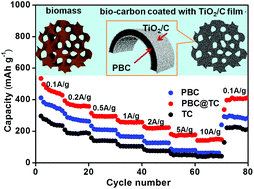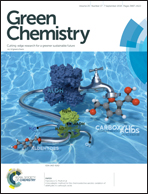Non-carbon coating: a new strategy for improving lithium ion storage of carbon matrix†
Abstract
Coatings with non-carbon films to improve the electrochemical performance of carbon materials have recently begun to gain attention. As one attempt in this field, we fabricated a thin TiO2/C composite film coated on porous biomass-derived biocarbon (PBC) (denoted as PBC@TC) by a facile sol–gel strategy. The experimental results exhibit an obvious Li+ storage capacity enhancement of the as-obtained PBC@TC sample compared with the uncoated sample, demonstrating the significant positive effect of the TiO2/C films on improving the electrochemical performance of the carbon matrix. Notably, the cycling stability of carbon materials can also be improved greatly by coating with this TiO2/C film, delivering an 86% capacity retention even after 10 000 cycles at 5 A g−1. When employed as anode materials in lithium ion capacitors (LICs), the resultant PBC@TC activate carbon LICs (PBC@TC//AC LICs) present an energy density of 130 W h kg−1 at a power density of 66.6 W kg−1 in a voltage range from 0 to 4 V, and a 90% capacity retention after 10 000 cycles at 5 A g−1. Therefore, besides chemical or physical activation and heteroatom doping, coating with TiO2/C films could be a new facile and green approach for improving lithium ion storage properties of carbon materials. Owing to the flexibility of the carbon matrix and film species, this strategy can be extended to other carbon matrix and non-carbon films, which could have potential for applications in exploring high-performance electrode materials.



 Please wait while we load your content...
Please wait while we load your content...